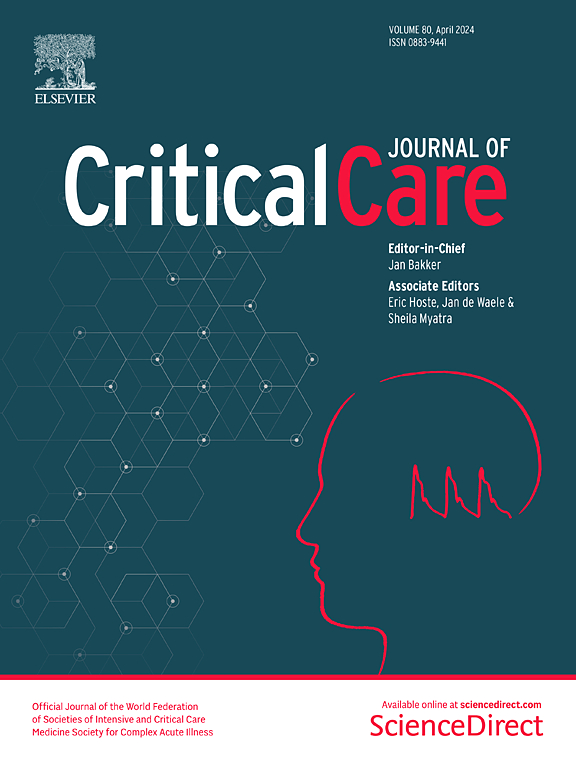一项生理学研究揭开了“机械悖论”的面纱
IF 8.8
1区 医学
Q1 CRITICAL CARE MEDICINE
引用次数: 0
摘要
最近的研究报道,胸壁负荷可能会降低气道压力并增加呼吸系统的顺应性,这与该操作的预期效果相反(“机械悖论”)。这项生理研究的目的是阐明这一现象背后的机制。20例接受有创机械通气治疗急性低氧性呼吸衰竭的患者进行了递减PEEP试验。在患者腹部放置可变重量,以使腹内压增加5mmhg。每个PEEP水平连续进行三个阶段:减重、增重和减重。食管压力测量和电阻抗断层扫描(EIT)。腹部重量降低了所有PEEP值的呼气末肺阻抗(EELI)和过胀,增加了塌陷(p值均< 0.001)。当PEEP值高于基于eit的最佳PEEP时,腹部体重降低呼吸系统和肺平台压力(系数[标准误差]分别为- 1.26[0.21]和- 5.51 [0.28],p值均< 0.001)以及驾驶压力(分别为- 1.47[0.22]和- 1.62 [0.22],p值均< 0.001)。当PEEP低于最优值时,腹部重量的应用效果相反(p值均< 0.001)。腹部负荷后呼吸系统和肺力学的改善是由于呼气末肺体积的减少。然而,这种影响仅发生在与普遍过度扩张相关的PEEP水平。这种简单安全的操作可以在床边应用,以识别肺过度扩张和滴定PEEP。ClinicalTrials.gov (NCT06174636, 2023年7月9日)。本文章由计算机程序翻译,如有差异,请以英文原文为准。
The “mechanical paradox” unveiled: a physiological study
Recent studies report that chest wall loading may reduce airway pressures and increase respiratory system compliance, contrary to the anticipated effect of this maneuver (“mechanical paradox”). Aim of this physiological study is to clarify the mechanism underlying this phenomenon. Twenty patients receiving invasive mechanical ventilation for acute hypoxemic respiratory failure were studied during a decremental PEEP trial. Variable weights were placed on the patients’ abdomen to achieve a 5-mmHg increase in intra-abdominal pressure. Three consecutive phases for each PEEP level were performed: weight-off, weight-on, and weight-off. Esophageal pressure measurement and electrical impedance tomography (EIT) were used. The abdominal weight decreased end-expiratory lung impedance (EELI) and overdistention and increased collapse for all PEEP values (all p-values < 0.001). For PEEP values higher than the EIT-based optimal PEEP, the abdominal weight reduced respiratory system and lung plateau pressures (coefficient [standard error] − 1.26 [0.21] and − 5.51 [0.28], respectively, both p-values < 0.001) and driving pressures (− 1.47 [0.22] and − 1.62 [0.22], respectively, both p-values < 0.001). For PEEP values lower than the optimal, the effect of the application of the abdominal weight was the opposite (all p-values < 0.001). The improvement in respiratory system and lung mechanics following abdominal loading is consequent to the reduction of end-expiratory lung volume. This effect, however, only occurs at PEEP levels associated with prevalent overdistention. This simple and safe maneuver could be applied at the bedside to identify lung overdistension and titrate PEEP. ClinicalTrials.gov (NCT06174636, July 9th 2023).
求助全文
通过发布文献求助,成功后即可免费获取论文全文。
去求助
来源期刊

Critical Care
医学-危重病医学
CiteScore
20.60
自引率
3.30%
发文量
348
审稿时长
1.5 months
期刊介绍:
Critical Care is an esteemed international medical journal that undergoes a rigorous peer-review process to maintain its high quality standards. Its primary objective is to enhance the healthcare services offered to critically ill patients. To achieve this, the journal focuses on gathering, exchanging, disseminating, and endorsing evidence-based information that is highly relevant to intensivists. By doing so, Critical Care seeks to provide a thorough and inclusive examination of the intensive care field.
 求助内容:
求助内容: 应助结果提醒方式:
应助结果提醒方式:


